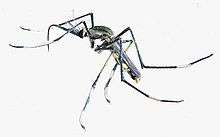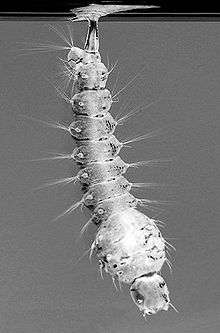Toxorhynchites
Toxorhynchites, also called elephant mosquito or mosquito eater, is a genus of diurnal and often relatively colorful mosquitoes, found worldwide between about 35° north and 35° south. It includes the largest known species of mosquito, at up to 18 mm (0.71 in) in length and 24 mm (0.94 in) in wingspan.[1] It is among the many kinds of mosquito that do not consume blood. The adults subsist on carbohydrate-rich materials, such as honeydew, or saps and juices from damaged plants, refuse, fruit, and nectar.[2]
| Toxorhynchites | |
|---|---|
 | |
| Toxorhynchites speciosus | |
 | |
| Toxorhynchites speciosus larva | |
| Scientific classification | |
| Kingdom: | |
| Phylum: | |
| Class: | |
| Order: | |
| Family: | |
| Genus: | Toxorhynchites Theobald, 1901 |
| Species | |
|
See text. | |
Their larvae prey on the larvae of other mosquitoes and similar nektonic prey, making Toxorhynchites beneficial to humans.[1] In this respect, they contrast with blood-sucking species of mosquitoes. Toxorhynchites larvae live on a protein- and fat-rich diet of aquatic animals such as mosquito larvae. They have no need to risk their lives sucking blood in adulthood, having already accumulated the necessary materials for oogenesis and vitellogenesis.
Most species occur in forests. The larvae of one jungle variety, Toxorhynchites splendens, consume larvae of other mosquito species occurring in tree crevices, particularly Aedes aegypti.
Unlike Toxorhynchites mosquitoes, detritus feeder mosquito female larvae rely on blood meals to produce eggs more plentifully than a diet of nectar would permit. And even though blood sucking is a risky strategy that entails more casualties, and they could in principle subsist on nectar and the like as their males generally do, the risk is outweighed on average by the increase in the number and size of yolk-rich eggs that such protein-rich food permit. Eggs are either white or yellow in color, found on water surfaces, and generally have an incubation period of 40-60 hours depending on the temperature. The older the female mosquito, the less likely the eggs will be healthy [3].
Environmental scientists have suggested that Toxorhynchites mosquitoes be introduced to areas outside their natural range in order to fight dengue fever. This has been practiced historically, but errors have been made. For example, when intending to introduce T. splendens to new areas, scientists actually introduced T. amboinensis.[4] An extinct species is known from Miocene aged Mexican Amber.[5]

Species
The genus Toxorhynchites is divided into 4 subgenera and contains 92 species:[6]
- Toxorhynchites bambusicolus (Lutz and Neiva, 1913)
- Toxorhynchites brevipalpis (Theobald)
- Toxorhynchites grandiosus (Williston, 1900)
- Toxorhynchites guadeloupensis (Dyar and Knab, 1906)
- Toxorhynchites haemorrhoidalis (Fabricius, 1787)
- Toxorhynchites hexacis (Martini, 1901)
- Toxorhynchites mariae (Bourroul, 1904)
- Toxorhynchites minimus ((Theobald, 1905))
- Toxorhynchites moctezuma (Dyar and Knab, 1906)
- Toxorhynchites portoricensis (Roeder, 1885)[7]
- Toxorhynchites purpureus (Theobald, 1901)
- Toxorhynchites pusillus (Lima, 1931)
- Toxorhynchites rajah (Tsukamoto, 1986)
- Toxorhynchites rutilus
- Toxorhynchites solstitialis (Lutz, 1904)
- Toxorhynchites speciosus (Skuse, 1889)
- Toxorhynchites splendens (Wiedemann)
- Toxorhynchites theobaldi (Dyar and Knab, 1906)
- Toxorhynchites trichopygus (Wiedemann, 1828)
- Toxorhynchites violaceus (Wiedemann, 1821)
References
- Cook, G.C.; Zumla, A (2009). Manson's Tropical Diseases (22 ed.). Saunders Elsevier. p. 1735. ISBN 978-1-4160-4470-3.
- BONNET, DAVID D.; HU, STEPHEN M. K. (1951). "The Introduction of Toxorhynchites brevipalpis Theobald into the Territory of Hawaii" (PDF). Proceedings of the Hawaiian Entomological Society. 14 (2): 237. Retrieved 30 September 2016.
- https://www.researchgate.net/profile/Larissa_Collins/publication/216675054_The_biology_of_Toxorhynchites_mosquitoes_and_their_potential_as_biocontrol_agents/links/0c960521635713fa59000000/The-biology-of-Toxorhynchites-mosquitoes-and-their-potential-as-biocontrol-agents.pdf
- http://www.cabi.org/bni/FullTextPDF/2000/20003030873.pdf
- T. J. Zavortink and G. O. Poinar. 2008. Toxorhynchites (Toxorhynchites) mexicanus, n. sp.. (Diptera: Culicidae) from Mexican amber: a new world species with old world affinities. Proceedings of the Entomological Society of Washington 110:116-125
- Toxorhynchites at the Integrated Taxonomic Information System.
- Röder, V. von (1885). "Diptera von Insel Portorico". Entomologische Zeitung. 46: 337–349.